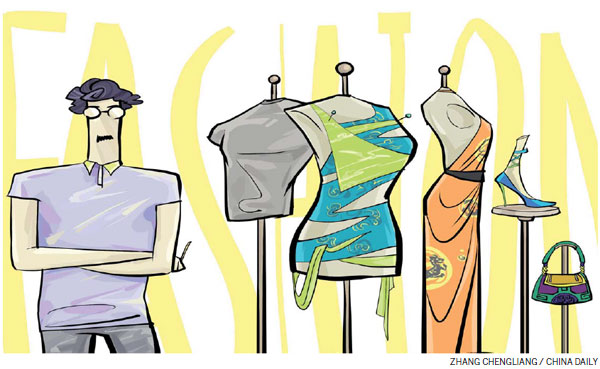Fashion's future: Young, gifted, Chinese
Updated: 2016-05-27 08:15
By Mike Bastin(China Daily Europe)
|
|||||||||
The distinctive and fresh work of more designers from China has been gracing catwalks at international haute couture events
Shanghai-based fashion brand Arete Studio provides a perfect example of the rapidly emerging, modern and dynamic Chinese fashion industry. Very exciting times indeed.
In April, Arete Studio, which launched in Shanghai in 2013, was one of only a few select brands invited to parade at the internationally prestigious Paris Fashion Week's AMF Paris Showroom.

Arete's founder and managing director, Jasmine Ting, has already attracted widespread praise across the Chinese mainland for her label's aesthetic appeal and versatile range.
In December, the acclaimed French festival A Shaded View on Fashion Film chose Arete's 2015 film collaboration with Hong Kong director Wing Shya to represent China. Couturier Jean Paul Gaultier - an icon most fashion designers couldn't fathom even showing their work to - presided over the jury at the event, which was held at the Centre Pompidou. Arete's feature made it to the finals and was nominated for best costume design, best art direction and best director at the International Fashion Film Awards.
The film itself is yet another example of the increasing, global critical acclaim received by Chinese fashion industry players.
Not that those at Arete are alone in their international expansion endeavor.

For quite some time, an increasing number of Chinese fashion designers have been, by invitation on many occasions, gracing the catwalks at international fashion weeks. Haizhen Wang (a luxury womenswear label based in London), Xander Zhou (collections that aim to preserve traditional Chinese culture through fashion, based in Beijing), Masha Ma (recent collections have been featured in Vogue and Elle) and Uma Wang (her eponymous label has recently showcased catwalk collections at London, Paris and Milan fashion weeks), to name but a few, continue to contribute to significant and sizable global recognition of the talented and creative Chinese fashion industry.
Most importantly, it is increasingly homegrown, domestic Chinese talent who are now being invited to showcase their work and ideas internationally, often at major fashion shows around the fashion cities of the world.
The times they are a-changing.
A perfect example of this seemingly unstoppable trend is Chinese Academy of Art graduate Min Wu. Wu's highly respected work, first displayed at London Fashion Week in September, was well received, as was this year's range.
Such is the attention and achievement now associated with this emerging pool of young Chinese fashion design talent that only a month or so ago, White Milano, one of the most prestigious international fashion shows on the industry's calendar, carved out an area dedicated to young talent from the Chinese mainland. This area was promoted with the banner "China Calling" and proved hugely popular among attendees. Sonja Long Xiao, founder of the Shanghai-based concept store Alter, was invited to organize the display of many rising Chinese fashion designers such as Nicole Zhang, Chen Yi Yuan and Shushu Tong.
Not that fashion capital Milan is the only place where nascent Chinese fashion designers are now making a superb splash. In May 2015 at the Met Gala in New York, rising Chinese star Guo Pei showcased her latest creations. Guo soon followed up on this international success with a debut appearance in January in Paris, where her latest designs, widely applauded for their variety of innovative styles, appeared during Haute Couture Week.
Clearly, young and exceptionally talented Chinese fashion designers are beginning to make their mark on the global fashion industry. A tangible belief in self and determination appears to underpin this talent, too.
But in order to succeed, these fresh-faced fashion designers also need to gain understanding of and experience in the steps needed to build strong and sustainable fashion brands. Creativity, of course a prerequisite in the fashion industry, may not lead to effective, emotional brand building.
What we now need to see from these Chinese fashion pioneers is evidence of careful, considered international market penetration plans and brand-building programs. A coherent strategy with a detailed target market profile per country or region, and a clear, valued and unoccupied market position are fundamental to any sustainable success overseas.
Of course, the first step in any success story is international brand awareness building, and it may well be that help is close at hand here for the growing group of fabulous and fearless fashion elites.
China's e-commerce industry is also growing and internalizing and, as a result, perhaps offers a perfect promotions platform upon which to begin global brand awareness building. The Chinese e-commerce company JD.com appears to be one of the most suitable here. In February, the online shopping platform held a fashion show as part of New York Fashion Week, a follow-up to last year's debut at Milan Fashion Week.
Not only is this a particularly astute brand-building move for JD.com, it was also a move carefully planned to associate with and advance the international plans of many of China's emerging and esoteric fashion designers.
Fast-emerging young designers such as Chi Zhang, Alicia Lee and Ruiping Guo were among the fortunate participants and beneficiaries in New York. Furthermore, in September in Milan, JD.com proudly presented and promoted the work of four emerging Chinese designers whose labels it actually stocks and sells online: Lin Gu, Ali Tan, Xiaoyan Xu and Ivy Hu.
But how to build on this excellent international market exposure and make meaningful progress in the competitive area of global brand building?
Two key pieces of advice here. First, while many Chinese companies are now well on the way with international market penetration and competitive brand building, it is perhaps IT equipment and mobile phone giant Huawei that leads the way most in this regard. Huawei has not only established itself in terms of consistently high levels of product quality and customer service, but is also building an emotional brand with a combination of suitable, strong associations such as sponsorship tie-ups with world famous teams like Arsenal Football Club.
Emerging Chinese fashion designers are apparently hungry for success and learning, and should look no further than Huawei and the path it has chosen in order to build a strong global brand.
Second, some sort of coalescing with a number of young, talented Chinese fashion designers could also accelerate international market awareness and presence. For example, appearing together at international fashion shows for a few years at least should lead to a disproportionately positive impact on the European fashion industry and European fashion consumers yet to sample their latest designs.
That said, collaboration, cooperation and learning from others generally should never replace each fashion designer's possibly unique talent and creativity. It is this that will finally propel many Chinese fashion designers to international stardom.
And above all else, young Chinese fashion designers should never forget that it is their mother country that has put them where they are and that this motherland, with its unique history and heritage, should shine through again and again in the visual appearance and symbolic imagery surrounding their latest designs.
The author is a visiting professor at the University of International Business and Economics in Beijing and a senior lecturer at Southampton University. The views do not necessarily reflect those of China Daily.
Today's Top News
Hundreds rescued as packed vessel capsizes
EU has to cope with outcome of British referendum
Four Chinese banks among world's 10 largest
Kiev swaps Russian detainees for Ukraine's Savchenko
Refugees relocated during major police operation
China calls for concerted anti-terror efforts
London's financial centre warns of dangers of Brexit
Russia blasts NATO for Cold War mentality
Hot Topics
Lunar probe , China growth forecasts, Emission rules get tougher, China seen through 'colored lens', International board,
Editor's Picks

|

|

|

|

|

|







